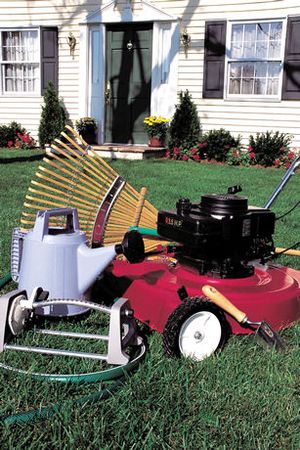Spring Into Better Lawn Care
With every warm spring day, many homeowners become more anxious to get out and start working on their lawns. But, as your grass begins to green up, resist the temptation to run out with the fertilizer spreader. A little patience at this point will reward you with a more vigorous and durable lawn.

The proper time to feed grass is in the fall, to build deep roots that will encourage nine months of cool-season growth and sustain the plants through the following summer. Even if you missed feeding your lawn last fall, limit spring feeding of established lawns to a light feeding between late April and early June (e.g., 1/2 pound of actual nitrogen, i.e., 5 pounds of 10-10-10, per 1000 sq. ft.) after the initial flush of growth has subsided. Select fertilizers that contain slow release nitrogen sources to green up the turf but not over-stimulate shoot growth. Do not apply more than 1 pound of actual nitrogen per 1,000 square feet.
You may need to reseed patches of winter-damaged lawn. Most lawn turf grasses grow best at soil pH's of 6.0 to 7.0, so have your soil's pH analyzed every two to three years to be sure you are staying in that range. Test results will also include application rate recommendations.
Before seeding, be sure to correct any chronic problems, like soil depressions or drainage ruts. Then, select the right seed mix for the site. Provide reseeded areas with adequate water and care from spring seeding through the hot, dry days of summer. This will allow your new sprouts to establish themselves, encourage vigorous root growth with a high phosphorous fertilizer (e.g., 25 pounds of 5-10-5 per 1000 square feet when patch seeding). Provide about 1 ½" of water weekly throughout the summer; don't be fooled by the top growth of your new grass plant because its roots are not as long and well-developed as those of an established lawn.
When it's time to get the mower out for the first time, be sure that you do not cut your grass too short. In spring, mow at a height of two inches, and then raise the cutting height another half inch when summer arrives. Never remove more than 1/3 of the grass blade when you mow. It's better to mow more often at a higher rate. If you allow the grass to get too tall before mowing, you risk stressing the plants and encouraging disease.
Through the growing season, a monthly, slow-release maintenance fertilizer such as organic, humic-based Gro-Power can be used to achieve good growth and color and help your lawn resist disease, weed, and pest infiltrations. Slow-release fertilizers also need less watering and seldom burn the turf. For native grass lawns, fertilize only once annually, in early fall. Apply a single application of Gro-Power 5-3-1 at the rate of 1 lb. of actual nitrogen (N) per 1000 sq. ft. of grass.
